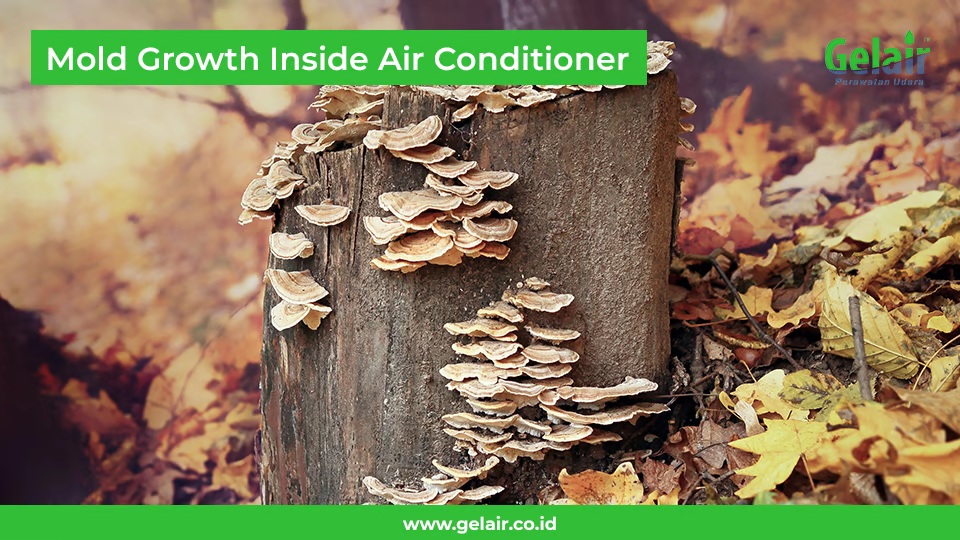Causes Of Mold Growth Within An Air Conditioner unit

Air Conditioner (AC) is a very important device in maintaining indoor comfort, especially during summer. However, sometimes air conditioners can face problems such as mold growth in them. Mold in air conditioners is not only an aesthetic issue, but it can also negatively affect the health and performance of the device. This article will discuss the causes of mold inside air conditioners and effective tips to prevent mold.
The country of Indonesia is included in a wet tropical climate or a warm humid area which is characterized by:
- Relatively high humidity (generally above 90%)
- High rainfall
- Annual temperatures above 18°C (and can reach 38°C in the dry season)
- The differences between seasons are not very noticeable, except for periods of little rain and lots of rain accompanied by strong winds.
High humidity helps the growth of microorganisms in the surrounding environment. In other words, molds will grow rapidly in places with high humidity. Mold growth begins when spores attach to a surface. Mold can grow within 24 - 48 hours, spreading black spots all over the surface. Any place that is damp can be a place for mold to spread, whether on walls, windows, floors, and furniture. Also, wherever mold is present, an unpleasant odor is always present.
Even worse, molds also have a negative impact on your health. The molds releases spores measuring 10 - 100 microns which contain mycotoxin, a toxin that the molds produces naturally. This mycotoxin can cause various health problems in humans, especially in people who are sensitive to mold. Health problems caused by mold include nasal congestion, eye irritation, coughing and sneezing, and skin irritation. People who are continuously exposed to mold can suffer from decreased lung function and can suffer from much more serious health problems, such as asthma, shortness of breath, rhinitis and eczema. People with weak immune systems, such as the elderly, children, and those undergoing chemotherapy, can also suffer from health problems due to exposure to molds.
The 3 types of mold that most often grow in the house and their effects on the body:
- Alternaria. Grows in damp and dark places. Causes asthma symptoms
- Aureobasidium. Commonly found in sinks and bathtubs. Cause digestive diseases and urinary tract infections (Urinary Tract Syndrome, UTI)
- Stachybotris. Grows in moist and wet places. Causes coughing, nose bleeds, and headaches. Stachybotris is the most dangerous of the three types. This type of fungus usually grows in building materials damaged by water and releases spores which are hazardous to health.
Indications of the presence of mold in the HVAC system are:
- Visible to the naked eye. Mold on the air conditioner can be black, brown, white, it also appears as black dust that has accumulated around the air vents. Accumulation of dust, dirt, mold and bacteria on the AC filter, leaks occur in the channel which makes it damp causing mold to grow
- An unusual smell (musty, rotten and damp smell) that is felt when the air conditioner is turned on, is often the first sign that there is mold in the air ducts or air vents
- The occupants of the room started showing symptoms every time the air conditioner was on. Symptoms include headache, nausea, irritated nose and sore throat, and itchy eyes. As a result, there are quite a lot of fungi in the AC system spreading dirty air in the room, so allergies appear like these symptoms.
The cause of mold on the HVAC system is the difference in temperature and humidity
- Very low temperature on the AC setting can sometimes cause mold around the vents. When cool air from the vents meets warm air in the room, the temperature difference can cause moisture in the air to condense on surfaces in and around the vents. The temperature difference usually takes about 20 degrees of difference for moisture to build up. If moisture builds up and never dries up, it can cause mold growth on the vents and air conditioning ducts
- The same problem arises when ducts have leaks, whereby the difference in temperature between the cold air in the duct and the warm air in the wall can cause moisture to condense in the duct, making it the perfect place for mold to grow.
Overcoming mold problems in the HVAC system, it is important to apply air treatment products (Air Treatment) and AC system cleaners (AC Cleaner) which have a special function to inhibit mold growth so as to prevent mold from coming back. Cleaning maintenance using only water or ordinary cleaners, then the molds will easily reappear.
Gelair Air Treatment is an air treatment product for HVAC systems. All Gelair products have a special formulation whose main ingredient is Australian Tea Tree Oil as an anti-microbial and anti-fungal agent and has a broad spectrum against MOLDS, BACTERIA and VIRUSES.
For further understanding of how Gelair Air Treatment product works against molds, please click the following link.